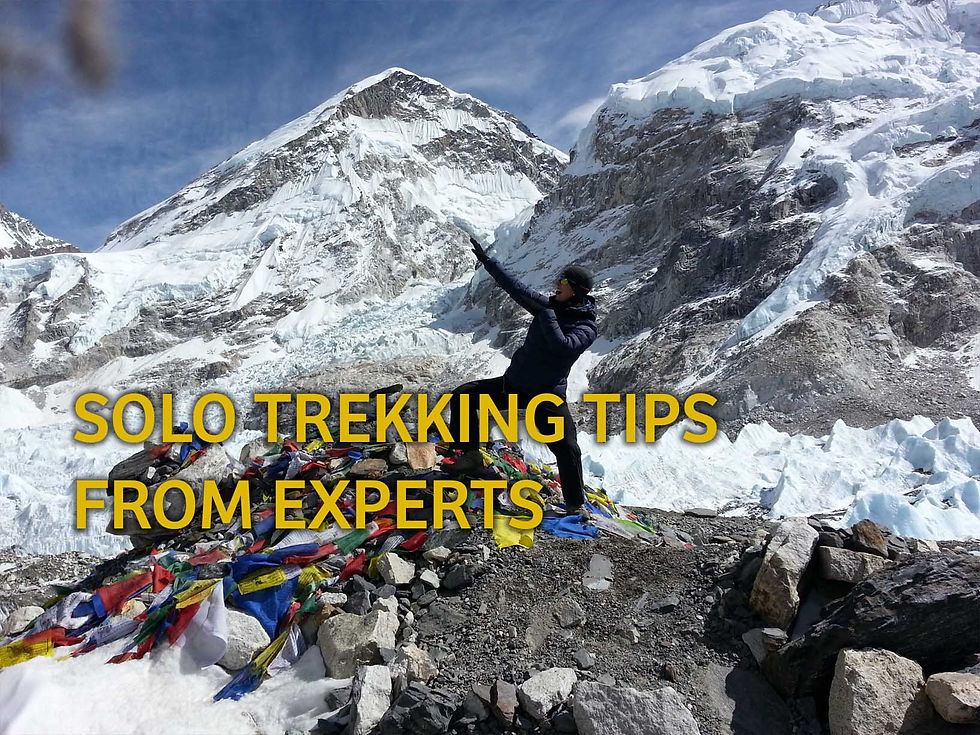Trekking alone? Best tips from solo trekkers
- India Trekking Club
- Feb 7, 2018
- 4 min read

Before starting the blog I want to ask from all the reader that what do you look for the most in a trek?
You can answer anything but two things will be common in everybody's answer as below: First thing is Good views, peace of mind, snow etc. and second is Physical and mental challenge with a dose of adventure.
If your answer falls in the first category, you are not essentially looking for a “tough” treks. Depending on what you prefer – valleys, summit views, water bodies, flora and fauna – you can choose a trek that offers these things. For example, if you love summit views, Kuari Pass would be the ideal option. Or if you enjoy birds, Sandakphu and Deoriatal are great options. If you have something in mind, just speak to anyone at Indiahikes, they’ll suggest your best option. But in this post, I want to focus on the second category. If greater physical or mental challenge is what you are looking for, I recommend that you try solo trekking. What makes solo trekking challenging Trekking on your own, without the support of an organisation such as Indiahikes, is a completely different ball game. You not only have to manage your own logistics, you also have to carry your gear, pitch campsites and cook for yourself. In the process, you learn that how you do a trek is as exciting as what trek you do. This is a truly challenging and adventurous way to do a trek. I learnt this many years ago when I’d just started my trekking journey. In 2014, my friends and I attempted the Indrahar Pass trek (14,245 ft). We went on our own, without a guide. It took us 4 days to reach the Pass and return to McLeodganj – we did not cross over to the other side. After the Indrahar Pass trek, I have done several longer treks climbing to higher altitudes, including the 9-day-long Goechala trek and 19,553 ft high Kanamo Peak. Despite this, I found Indrahar Pass to be more challenging. Despite having done Kanamo Peak that climbs to over 19,000 ft, Karthik found solo trekking to Indrahar Pass, which climbs to 14,000 and odd ft, much more difficult It was tougher because I was completely dependent on my own preparation and had nobody to fall back on. The excitement of reaching such a high altitude on a tough trail on my own was incomparable. Because I would like you to at least consider solo trekking, I’m going to give you a quick top-down on how to go about it. How to prepare for a solo trek Taking the plunge to go on a solo trek can be daunting. A lot of questions may have already started popping in your mind. How do I select a trek? How do I ensure nothing goes wrong? Am I even capable of trekking on my own? The five points that I will explain here will help you to get started. 1. Start with short treks For you first solo trek, choose something small, like a two day trek. The Indiahikes DIY section has several options. These guides give you a fair idea of the itinerary. Once you gain some experience, gradually increase the duration to 3 days and so on. The more you trek on your own, the more efficient you will become. In fact, you will realize over time that your gear is lighter on your longer treks than it was on your first two-day trek. 2. Work on your fitness Every trek you go on requires a certain level of fitness. You walk long distances on unfamiliar terrain. There could be inclines, rocky or uneven trails, river crossings and even snow! On a solo trek, being fit is even more important. Not only do you have to trek long distances, you also have to set up your own camp, carry water from sources, dig a cat hole for yourself, cook and clean up once you are done. You have only yourself to rely on to do all this. Negotiating all of this successfully requires you to be physically and mentally strong. You can develop this strength and endurance through a sustained fitness routine. Read about the fitness level required for a trek well in advance and work towards it. Trekking with all your gear, including sleeping bags, tents, first aid kits, etc requires much higher levels of fitness than going on an organised trek. So be doubly prepared, says Karthik
3. Learn the basics of health and first aid If possible, attend a course in Basic Life Saving and Basic First Aid (BLS & BFA). This is a short course (usually 2-3 days) that most hospitals offer. Pack basic medicines and first aid material that you will require. Take a doctor’s help if you are not sure of which medicines to carry. You can also find a basic list in the trek guides on the Indiahikes website. If you’re going on a high altitude trek, it’s imperative that you know about altitude sickness, its many forms, and its treatment. There’s Acute Mountain Sickness, HAPE, HACE. Lack of this knowledge at high altitude can be fatal. So educate yourself about this before stepping into high altitude.





























Comments